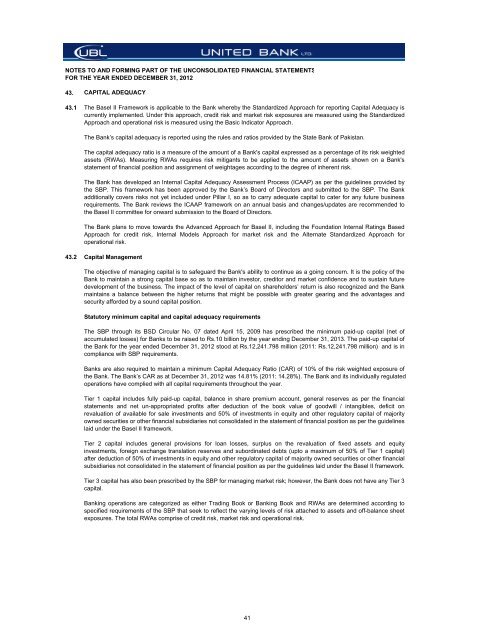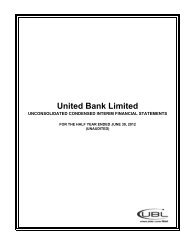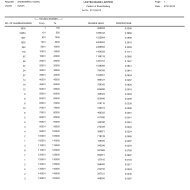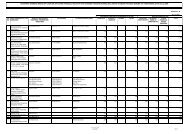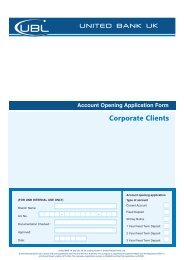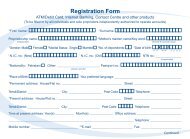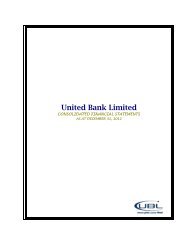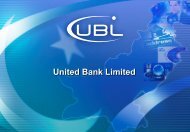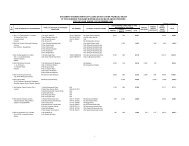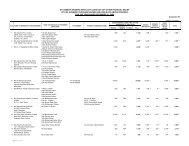Financial Statements - United Bank Limited
Financial Statements - United Bank Limited
Financial Statements - United Bank Limited
Create successful ePaper yourself
Turn your PDF publications into a flip-book with our unique Google optimized e-Paper software.
NOTES TO AND FORMING PART OF THE UNCONSOLIDATED FINANCIAL STATEMENTS<br />
FOR THE YEAR ENDED DECEMBER 31, 2012<br />
43. CAPITAL ADEQUACY<br />
43.1<br />
The Basel II Framework is applicable to the <strong>Bank</strong> whereby the Standardized Approach for reporting Capital Adequacy is<br />
currently implemented. Under this approach, credit risk and market risk exposures are measured using the Standardized<br />
Approach and operational risk is measured using the Basic Indicator Approach.<br />
The <strong>Bank</strong>’s capital adequacy is reported using the rules and ratios provided by the State <strong>Bank</strong> of Pakistan.<br />
The capital adequacy ratio is a measure of the amount of a <strong>Bank</strong>'s capital expressed as a percentage of its risk weighted<br />
assets (RWAs). Measuring RWAs requires risk mitigants to be applied to the amount of assets shown on a <strong>Bank</strong>'s<br />
statement of financial position and assignment of weightages according to the degree of inherent risk.<br />
The <strong>Bank</strong> has developed an Internal Capital Adequacy Assessment Process (ICAAP) as per the guidelines provided by<br />
the SBP. This framework has been approved by the <strong>Bank</strong>’s Board of Directors and submitted to the SBP. The <strong>Bank</strong><br />
additionally covers risks not yet included under Pillar I, so as to carry adequate capital to cater for any future business<br />
requirements. The <strong>Bank</strong> reviews the ICAAP framework on an annual basis and changes/updates are recommended to<br />
the Basel II committee for onward submission to the Board of Directors.<br />
The <strong>Bank</strong> plans to move towards the Advanced Approach for Basel II, including the Foundation Internal Ratings Based<br />
Approach for credit risk, Internal Models Approach for market risk and the Alternate Standardized Approach for<br />
operational risk.<br />
43.2 Capital Management<br />
The objective of managing capital is to safeguard the <strong>Bank</strong>'s ability to continue as a going concern. It is the policy of the<br />
<strong>Bank</strong> to maintain a strong capital base so as to maintain investor, creditor and market confidence and to sustain future<br />
development of the business. The impact of the level of capital on shareholders’ return is also recognized and the <strong>Bank</strong><br />
maintains a balance between the higher returns that might be possible with greater gearing and the advantages and<br />
security afforded by a sound capital position.<br />
Statutory minimum capital and capital adequacy requirements<br />
The SBP through its BSD Circular No. 07 dated April 15, 2009 has prescribed the minimum paid-up capital (net of<br />
accumulated losses) for <strong>Bank</strong>s to be raised to Rs.10 billion by the year ending December 31, 2013. The paid-up capital of<br />
the <strong>Bank</strong> for the year ended December 31, 2012 stood at Rs.12,241.798 million (2011: Rs.12,241.798 million) and is in<br />
compliance with SBP requirements.<br />
<strong>Bank</strong>s are also required to maintain a minimum Capital Adequacy Ratio (CAR) of 10% of the risk weighted exposure of<br />
the <strong>Bank</strong>. The <strong>Bank</strong>’s CAR as at December 31, 2012 was 14.81% (2011: 14.28%). The <strong>Bank</strong> and its individually regulated<br />
operations have complied with all capital requirements throughout the year.<br />
Tier 1 capital includes fully paid-up capital, balance in share premium account, general reserves as per the financial<br />
statements and net un-appropriated profits after deduction of the book value of goodwill / intangibles, deficit on<br />
revaluation of available for sale investments and 50% of investments in equity and other regulatory capital of majority<br />
owned securities or other financial subsidiaries not consolidated in the statement of financial position as per the guidelines<br />
laid under the Basel II framework.<br />
Tier 2 capital includes general provisions for loan losses, surplus on the revaluation of fixed assets and equity<br />
investments, foreign exchange translation reserves and subordinated debts (upto a maximum of 50% of Tier 1 capital)<br />
after deduction of 50% of investments in equity and other regulatory capital of majority owned securities or other financial<br />
subsidiaries not consolidated in the statement of financial position as per the guidelines laid under the Basel II framework.<br />
Tier 3 capital has also been prescribed by the SBP for managing market risk; however, the <strong>Bank</strong> does not have any Tier 3<br />
capital.<br />
<strong>Bank</strong>ing operations are categorized as either Trading Book or <strong>Bank</strong>ing Book and RWAs are determined according to<br />
specified requirements of the SBP that seek to reflect the varying levels of risk attached to assets and off-balance sheet<br />
exposures. The total RWAs comprise of credit risk, market risk and operational risk.<br />
41


